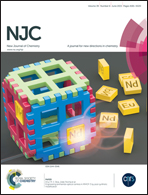Trinuclear and tetranuclear cyclopentadienyl vanadium carbonyl clusters: unusual carbonyl groups in Herrmann's (C5H5)4V4(CO)4 exhibiting low CO stretching frequencies†
Abstract
The pyrolysis of Cp2V2(CO)5 in tetrahydrofuran solution is reported by Herrmann and co-workers to give a tetranuclear Cp4V4(CO)4 cluster as a major product and the trinuclear Cp3V3(CO)9 as a minor product. Neither of these products has been characterized structurally. A theoretical study of the Cp4V4(CO)4 system reveals a complicated energy surface having 10 structures within 25 kcal mol−1 of the global minimum encompassing singlet, triplet, and quintet spin states. The lowest energy Cp4V4(CO)4 structures are nearly degenerate (within 1 kcal mol−1) triplet and singlet structures with a central V4 distorted tetrahedron with a μ3-CO group bridging each face. Higher energy singlet and triplet Cp4V4(CO)4 structures are also found with a central V4 butterfly and an unusual η2-μ4-CO group bridging all four vanadium atoms through four V–C bonds and one V–O bond. None of the ten Cp4V4(CO)4 structures has any terminal CO groups, which is totally different from the Cp4V4(CO)4 structure with exclusively terminal CO groups suggested from the experimental work. The lowest energy Cp3V3(CO)9 structure has a central equilateral V3 triangle and all terminal CO groups. However, this Cp3V3(CO)9 structure is disfavored by ∼34 kcal mol−1 relative to fragmentation into the stable compounds CpV(CO)4 + Cp2V2(CO)5 consistent with its low yield in the Cp2V2(CO)5 pyrolysis.


 Please wait while we load your content...
Please wait while we load your content...